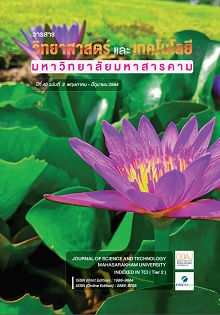การเปรียบเทียบกระบวนการจำแนกภาพถ่ายดาวเทียมแบบ Nearest Neighbor (NN) โดยการเลือกกลุ่มตัวอย่างจากวัตถุภาพและข้อมูลเวกเตอร์แบบจุด: กระบวนการจำแนกแบบเชิงวัตถุ
Main Article Content
บทคัดย่อ
การศึกษานี้มีวัตถุประสงค์เพื่อจำแนกภาพถ่ายดาวเทียมรายละเอียดสูงโดยใช้กระบวนการวิเคราะห์แบบเชิงวัตถุโดยการเปรียบเทียบกระบวนการในการสุ่มตัวอย่างวัตถุภาพ 2 กระบวนการได้แก่ (1) การสร้างจุดตัวอย่างโดยตรงจากการแปลภาพถ่ายด้วยสายตาและ (2) การเลือกกลุ่มตัวอย่างจากวัตถุภาพที่ตัดวัตถุภาพแล้วโดยจำแนกแบบ Nearest Neighbor Classifier (NN) จุดตัวอย่างจากกระบวนการที่ (1) ประกอบด้วย 46 จุดสุ่มและวัตถุภาพที่เลือกจากกระบวนการวิเคราะห์ที่ (2) ประกอบด้วย 36 วัตถุภาพครอบคลุม 5 ชั้นการจำแนกได้แก่ (1) หลังคาเรือน (2) ไม้ยืนต้น (3) แหล่งน้ำ (4) นาข้าวและ (5) พืชไร่ สำหรับการจำแนกแบบที่ 2 ได้เลือกกลุ่มตัวอย่างจากวัตถุภาพที่ถูกตัดแล้วโดยเลือกให้ตรงกับจุดตัวอย่างในกระบวนการที่ 1 และใช้เกณฑ์ในการจำแนกทั้ง 2 วิธีภายใต้คุณสมบัติและเงื่อนไขเดียวกัน ผลการศึกษาพบว่า การจำแนกแบบที่ (1) มีความความถูกต้องโดยรวมร้อยละ 85.71 Khat มีค่าเท่ากับ0.82 โดยในกระบวนการนี้พบว่าไม้ยืนต้นมีค่าความถูกต้องสูงสุด Users’ accuracy 94% และมีค่าต่ำสุดได้แก่แหล่งน้ำคิดเป็นร้อยละ 74 สำหรับการจำแนกแบบที่ (2) มีความความถูกต้องโดยรวมร้อยละ 79.19 และ Khat มีค่าเท่ากับ 0.73 โดยในกระบวนการนี้พบว่าไม้ยืนต้นมีค่าความถูกต้องสูงสุด Users’ accuracy 87% และมีค่าต่ำสุดได้แก่นาข้าว (Paddy field) คิดเป็นร้อยละ 65 ตามลำดับ
Article Details
เอกสารอ้างอิง
2. Huang H, Lan Y, Yang A, Zhang Y, Wen S, Deng J. Deep learning versus Object-based Image Analysis (OBIA) in weed mapping of UAV imagery. International Journal of Remote Sensing. 2020 May 2;41(9):3446–79.
3. Hegyi A, Vernica M-M, Drăguţ L. An object-based approach to support the automatic delineation of magnetic anomalies. Archaeological Prospection. 2020;27(1):3–12.
4. Song A, Kim Y, Han Y. Uncertainty Analysis for Object-Based Change Detection in Very High-Resolution Satellite Images Using Deep Learning Network. Remote Sensing. 2020 Jan;12(15):2345.
5. Object-based spectral quality assessment of high-resolution pan-sharpened satellite imageries: new combined fusion strategy to increase the spectral quality | SpringerLink [Internet]. [cited 2020 Dec 23]. Available from: https://link.springer.com/article/10.1007/s12517-020-05523-3
6. Papakonstantinou A, Stamati C, Topouzelis K. Comparison of True-Color and Multispectral Unmanned Aerial Systems Imagery for Marine Habitat Mapping Using Object-Based Image Analysis. Remote Sensing. 2020 Jan;12(3):554.
7. Wu Y, Zhang X. Object-Based Tree Species Classification Using Airborne Hyperspectral Images and LiDAR Data. Forests. 2020 Jan;11(1):32.
8. Delfan E, Naghavi H, Maleknia R, Nouredini A. Comparing the Capability of Sentinel 2 and Landsat 8 Satellite Imagery in Land Use and Land Cover Mapping Using Pixel-based and Object-based Classification Methods. Desert Ecosystem Engineering Journal. 2020 Jan 10;8(25):1–12.
9. Lubis AR, Lubis M, Khowarizmi A-. Optimization of distance formula in K-Nearest Neighbor method. Bulletin of Electrical Engineering and Informatics. 2020 Feb 1;9(1):326–38.
10. Luo S, Miao D, Zhang Z, Wei Z. Non-numerical nearest neighbor classifiers with value-object hierarchical embedding. Expert Systems with Applications. 2020 Jul 15;150:113206.
11. Cariou C, Chehdi K, Moan SL. Improved Nearest Neighbor Density-Based Clustering Techniques with Application to Hyperspectral Images. In: ICASSP 2020 - 2020 IEEE International Conference on Acoustics, Speech and Signal Processing (ICASSP). 2020. p. 4127–31.
12. Tang Z, Wang H, Li X, Li X, Cai W, Han C. An Object-Based Approach for Mapping Crop Coverage Using Multiscale Weighted and Machine Learning Methods. IEEE Journal of Selected Topics in Applied Earth Observations and Remote Sensing. 2020;13:1700–13.
13. Wang Z, Li X, Jin J, Liu Z, Liu W. Unsupervised Clustering of Neighborhood Associations and Image Segmentation Applications. Algorithms. 2020 Dec;13(12):309.
14. Myint SW, Gober P, Brazel A, Grossman-Clarke S, Weng Q. Per-pixel vs. object-based classification of urban land cover extraction using high spatial resolution imagery. Remote Sensing of Environment. 2011 May 15;115(5):1145–61.
15. Laliberte AS, Rango A, Herrick JE, Fredrickson EL, Burkett L. An object-based image analysis approach for determining fractional cover of senescent and green vegetation with digital plot photography. Journal of Arid Environments. 2007 Apr 1;69(1):1–14.
16. Zhai D, Dong J, Cadisch G, Wang M, Kou W, Xu J, et al. Comparison of Pixel- and Object-Based Approaches in Phenology-Based Rubber Plantation Mapping in Fragmented Landscapes. Remote Sensing. 2018 Jan;10(1):44.
17. Wang X, Liu S, Du P, Liang H, Xia J, Li Y. Object-Based Change Detection in Urban Areas from High Spatial Resolution Images Based on Multiple Features and Ensemble Learning. Remote Sensing. 2018 Feb;10(2):276.
18. Radoux J, Bogaert P. Good Practices for Object-Based Accuracy Assessment. Remote Sensing. 2017 Jul;9(7):646.
19. Costa H, Foody GM, Boyd DS. Supervised methods of image segmentation accuracy assessment in land cover mapping. Remote Sensing of Environment. 2018 Feb 1;205:338–51.
20. Cai L, Shi W, Miao Z, Hao M. Accuracy Assessment Measures for Object Extraction from Remote Sensing Images. Remote Sensing. 2018 Feb;10(2):303.
21. Kramm T, Hoffmeister D, Curdt C, Maleki S, Khormali F, Kehl M. Accuracy Assessment of Landform Classification Approaches on Different Spatial Scales for the Iranian Loess Plateau. ISPRS International Journal of Geo-Information. 2017 Nov;6(11):366.
22. Ma L, Li M, Ma X, Cheng L, Du P, Liu Y. A review of supervised object-based land-cover image classification. ISPRS Journal of Photogrammetry and Remote Sensing. 2017 Aug 1;130:277–93.


